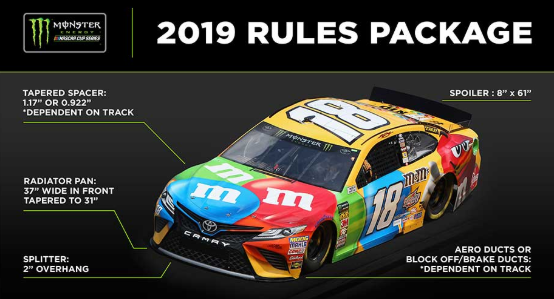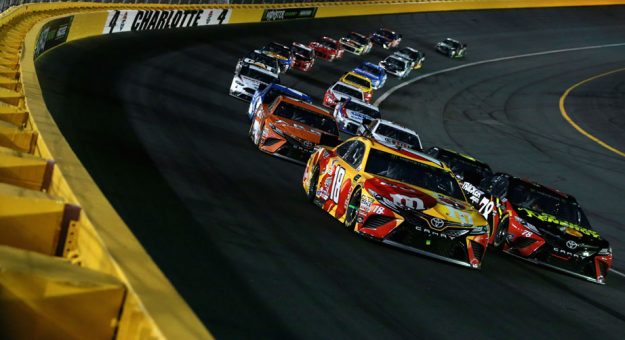NASCAR 2019 Rules Package Changes
2019 NASCAR Monster Energy Cup Series Changes Preview
by Jay Horne of NASCARWagers.com, NASCAR Handicapping Service
Happy New Year to all of our readers! With the dawn of a New Year, it means that another NASCAR season is just around the corner. In a little over a month, the engines will fire for the first time at Daytona International Speedway for the 2019 season. As we anticipate another profitable year in terms of betting on NASCAR races, we wanted to take a moment and highlight many of the important changes that will be noticeable during the upcoming 2019 campaign. We have new drivers entering the sport, drivers moving to different teams, and a brand new rules package that will be unveiled that is surely going to shake things up a bit. We will provide a full breakdown on the driver and team changes closer to the start of Daytona Speedweeks as some of these offseason moves could still change over the next month. For now, we wanted to take some time to provide a breakdown of the NASCAR 2019 rules package changes that will be most critical for bettors when the season begins.
2019 Rules Package Changes
Perhaps the most challenging change coming to NASCAR in 2019 from a betting standpoint is the imminent rules package that will be in effect this season. NASCAR announced the changes in October 2018 in hopes to produce closer racing at the front of the field. If you remember, the bulk of the rules package controversy stemmed from the All Star Race at Charlotte Motor Speedway last May when the Cup Series ran restrictor plates on the engines for the first time in the modern era on a 1.5 mile speedway. After what many fans considered an exciting All Star Race, NASCAR pushed forward with changes for the 2019 season in effort to vamp the competition factor. For 2019, NASCAR will not run “restrictor plates” per say but instead will downsize the tapered spacer. The ultimate result will act similarly to restrictor plates by limiting the amount of airflow through the engine causing a direct decrease in overall horsepower.
The tapered spacer will be downsized from the 2018 measurements of 1.17 inch to .922 for the upcoming season. While the difference in sizes appear minimal, the difference will be rather significant. In computer simulations, Monster Energy Cup Series cars are expected to lose about 200 horsepower (from 750 to 550). Additional changes have also been modified to both the rear spoiler and splitter to affect overall downforce. The racing over the last few seasons have been a product of a lower downforce package. This year the rear spoiler will be increased from 2.375 inches to a rather significant 8 inches in height. The front splitter will also have a 2 inch overhang which will certainly add some stability to the handling of the cars combined with the raised rear spoiler. Last but not least, cars will use aero ducts at tracks of 1.0 mile or greater in length. Aero ducts are used to move air to the side of the car rather than on the front nose. The aero ducts help trailing cars by limiting the amount of air on the front nose and NASCAR hopes this will produce closer racing.

Which tracks will feature the 2019 rules changes?
The primary goal for NASCAR is to create better racing at all tracks. As a result, the 2019 rules package changes will primarily affect the racing on the surfaces that are at least 1.0 mile or greater. Short tracks and road courses will not have any changes to the tapered spacer or air ducts. Likewise, the typical restrictor plate tracks of Daytona and Talladega will run their previous plate packages for the most part. All tracks that are 1 mile or greater in length will run the smaller tapered spacers and aero ducts. The only exception will be the tracks of Pocono, Atlanta, Darlington, and Homestead which will not feature the aero ducts that move the air to the side of the car.
2019 Rules Package Expectations
So what does all of these changes really mean and will it have any effect on bettors in 2019? After all, it is not uncommon for NASCAR to shake up the rules package before each season. However, I think most people would agree that this year’s changes are rather significant. We have essentially did a complete 180 from the low downforce package. The new rules package will provide much better handling for drivers with increased downforce and the cars will be somewhat slower especially down the straightaways. Personally, I am not the biggest fan of the changes. I thought the low downforce package was great for NASCAR because it highlighted the driver’s talent. Drivers will not have to muscle the car nearly as much this season and perhaps not have to drive it on the edge to reach optimum speed.
Instead I expect handling to be a bigger focus for teams this season. Handling is always important for a driver but speed was the premium under the prior package. It seems almost counter intuitive to say handling will be more important speed. However in a sense, I believe that statement will be true. With horsepower reduced, the disparity in lap times will likely be narrowed. From a driver’s standpoint, there will be more time the driver is “on” the throttle. In fact, corner speed could be very close if not a touch better under this new package if drivers can stay in the throttle with the help of the increased downforce. As a result, teams that can nail the handling on the setup will be in good position to thrive.
As always with any rules package changes, teams will be fighting to learn the best ways to make the most out of this package. Under the lower downforce package, Toyota teams undeniably dominated. They simply had things figured out. Will that trend continue? Possibly, but with the tighter racing I doubt we will see domination the likes of Kevin Harvick, Kyle Busch, and Martin Truex have flexed over the last two seasons. One of the most important items under this new rules package that I have not heard anyone discuss is “tire wear.” I think tire wear could become one of the most important aspect for teams/drivers success this year. This new rule package will not necessarily create any more or less tire wear. However, I think impacts of tire wear will be more critical towards overall speed in 2019. We saw this in the 2018 All Star Race and I believe it will be a theme throughout the season. The majority of the cars will start off equally and then after 8-10 laps, the cars with the better overall speed/tire wear will prevail.
Ultimately, I believe bettors should proceed with caution throughout the early part of the season until this rules package is clearly defined from a racing standpoint. The purpose of the package is to increase racing and passing. If that is the case, it could be more of a crap-shoot from a handicapping perspective at certain tracks. I don’t personally think we will see changes that will completely derail some of the driver trends that we have seen in recent years but I don’t expect to see results mirror those from previous years either. As with any changes, we will know more after the first few weeks of the season. Let’s just hope we are on the winning side to those changes!

